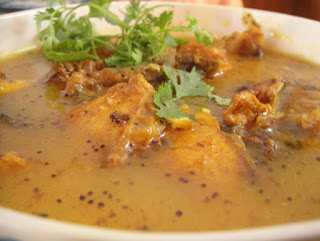Indian Assamese Sour Fish Curry

Indian Assamese Sour Fish Curry Recipe only Assam is a landlocked state in the northeast of India; however it is on the Ganges flood plain and much of its inhabitants' staple diet consists of river fish. I have used Blue-eye in this recipe, but you can replace it with whatever firm white fish you like. Curry leaves are used in many Indian dishes and they add extra depth and flavor to the curry. INGREDIENTS 1 tablespoon coriander seeds 2 teaspoons cumin seeds 1/2 teaspoon ground turmeric 1 teaspoon black peppercorns 2 cm piece fresh ginger, chopped coarsely 2 garlic cloves, chopped coarsely 2 tablespoons vegetable oil 4 Blue-Eye cutlets 2 medium brown onions, sliced thinly 1 1/2 teaspoons black mustard seeds 4 fresh curry leaves 180 ml water 80 ml fish stock 60 ml fresh lime juice 1 tablespoon fish sauce METHOD 1. Dry-fry turmeric, coriander and cumin seeds in a small pan, stirring until fragrant. Using a mortar and pestle, crush spice with the peppercorns, ginger, garlic and chili...






